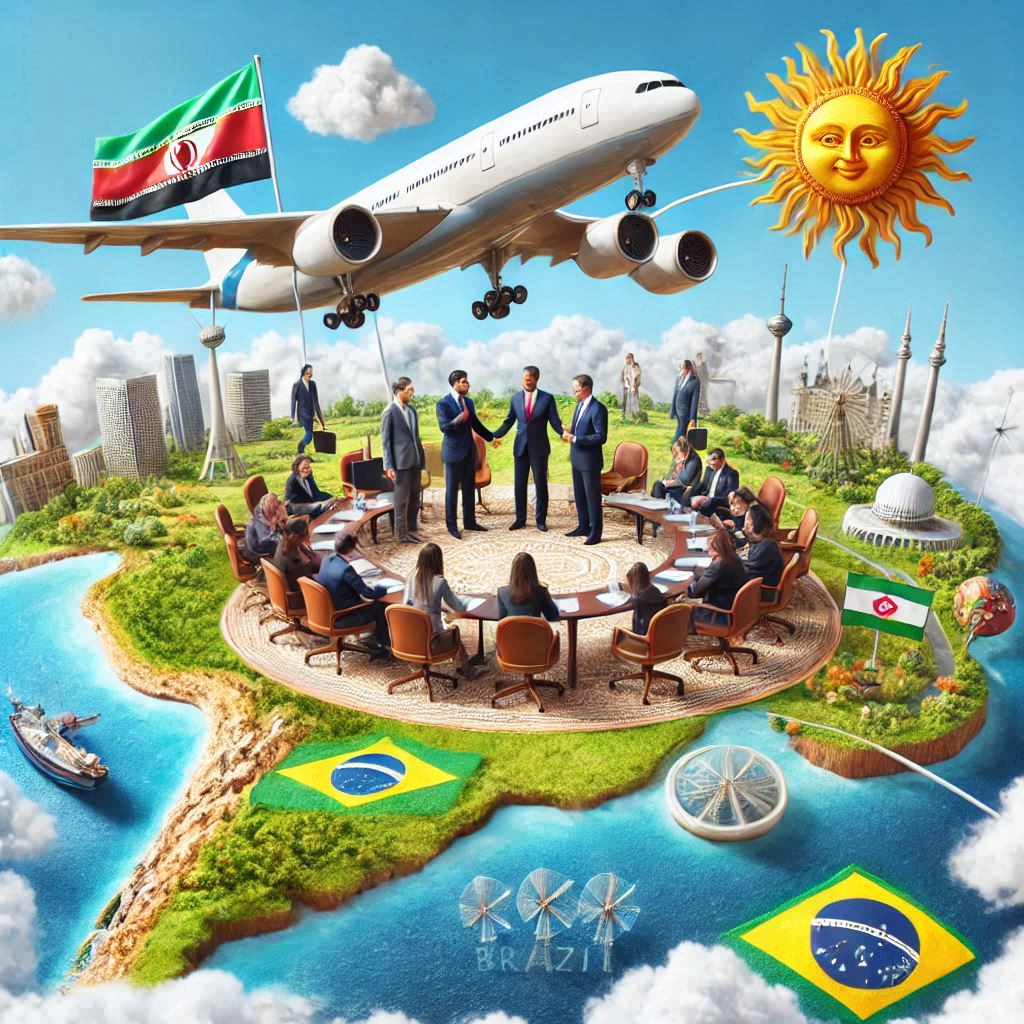Road to Belém begins in Baku
Maximizing Funding for Climate Change: the fight for money

Article by Valerio Rosa
The first nine months of 2024 registered the warming of the planet by an alarming 1.54°C1 as compared to the pre-industrial temperature average which is dangerously above the 1.5°C limit set by the Paris agreement. While the long-term pattern is still slightly below this limit, the last decade has been the hottest period ever registered with rising heat content in oceans being a major factor behind the increase in global temperature.
Indeed, the Antarctic sea’s ice reached this year its second lowest recorded extent ever and this has hugely increased the loss of icebergs and the rapid changes in ice-covered regions. At the same time, the consequences brought about by weather fluctuations and natural disasters have become more frequent due to the climate crisis. These have resulted in enormous damage in terms of people and the economy. Increasing catastrophes such as severe floods, extreme shifts in temperatures, and endless droughts are the manifestation of a clear picture of a future world dominated by the effects of climate change and global warming, reinforcing the need to fight climate change.
November 24th, the closing day of the COP29 in Baku, confirmed to be close to a flop. However, the delegates managed, and not without the harsh declarations of India, Nigeria, and some of the least developed and small island states, to agree to reconsider the Paris Agreement on climate financing. The new financial contribution from developed countries will triplicate to $300bn annually for developing countries by 2035. It includes a provision for scaling up funding from public and private sources, which should reach 1.3 trillion per year by 2035. However, this funding is still questioned due to significant concerns regarding private finance engagement. However, even the “New collective quantified goal on climate finance. Draft decision. Proposal by the President” underlines the gap between the offered aid and the real needs of the most vulnerable countries, which happen to be mainly part of the countries’ developing group.
A high contrast arises between developed and developing countries about COP29. From the financial viewpoint, it can be noticed how the definitions of “developed and developing countries” are quite outdated, linked to the United Nations Framework Convention on Climate Change and its two annexes of 1992. Notably, the Annex II list of the UNFCCC is derived from the membership of the Organisation for Economic Co-operation and Development (OECD) as of 1992. However, today the global picture has changed since then, therefore a revision of these labels should be carefully carried out. In addition, the Chinese effort in the financing of developing countries is not considered within this framework, even accounting for 6.1% of the total climate finance developed countries provided during the period 2013-2022. The list is longer, and a study defined the current state of potential countries that could join the financing group.
Developing countries are more concerned about the effects of climate change. In fact, the most affected countries are from this group. As visible in the following figure, the richer countries are the less affected by temperature variations. The concern in least-developed countries is linked to large shares of the population moving into extreme poverty conditions or destruction as for some small island states. This outlines the urgent need for these countries to the direct deployment of financial resources to address the climate crisis. In fact, the graph illustrates the relationship between climate variability and economic wealth, represented by GDP per person, for countries around the world. It is designed to highlight how different regions are expected to experience varying levels of climate variability over time, particularly as global temperatures rise. This shows the inequities of climate change, with poorer nations bearing the brunt of increased variability despite contributing less to global emissions.

While, the idea behind the EU and the other developed countries is to turn the global financial age into a new form. The small contribution towards developing countries should be the enabler of the private sector investments. This inflow of money must be guaranteed by ensuring the sustainability of revenues from still-risky climate investments. This should be part of a bigger institutional work both toward the private sector and the beneficiaries to cope with high costs of capital, limited fiscal space, unsustainable debt levels, high transaction costs, and conditionalities in climate finance.
It is clear that COPs need reforms to be able to deal with a changing international system and keep alive a future for the next generation. However, Baku until now represented another gathering of delegations which agreed with large dissent on a new idea of climate financing. This should be seen as a beginning and cannot represent the finish of the Baku COP29 otherwise our road to Belém will become more similar to the hotter circles in Dante’s hell or even worse the in-between Limbo. What the international arena needs is a new idea a new way of turning climate financing into a set system.
Vision Think Tank has developed three ideas to tackle the issues that have also appeared during COP29.
Financial Reform: A Catalyst for Real Change
The world urgently needs COP to step up with a smarter, more effective approach to climate financing. Right now, the sheer number of separate funds makes it hard to see where the money is going and whether it’s making a difference. Imagine the impact if we focused on just a few well-defined funds: two major ones for energy transition and adaptation, plus smaller ones for research and testing new technologies. Instead of dividing countries into "developed" and "developing," we should ask everyone to contribute based on their GDP and emissions. This way, every nation pulls its weight, but vulnerable communities still get the protection and support they need. The goal is to use this money wisely—helping make climate projects appealing to private investors while also funding those essential but less profitable initiatives. A dedicated executive body to track progress would ensure transparency and keep everyone accountable.
Decision-Making: Streamlining for Action
COP's decision-making process, while inclusive, often moves too slowly to match the urgency of the climate crisis. It’s time to rethink how decisions are made. One way is to group countries with similar challenges or interests, which could make discussions more focused and productive. Key players like the USA, China, and India, along with regional alliances like the EU, African Union, and ASEAN, should have prominent seats at the table. But COP also needs to give formal roles to city leaders, advocates for shared global resources like the oceans, and citizens—especially young people, who will inherit the planet we’re fighting for. A smaller, 15-member decision-making body could act faster while ensuring that everyone’s voice still matters.
Modernizing COP Governance
The current structure of COP was built for a different era, and it shows. Climate change doesn’t stop at borders, and neither should our solutions. A leaner, more inclusive "climate government" could better reflect the interconnected challenges we face today. Cities, regions, and non-state actors—already doing so much on the front lines—should have a bigger say. While large annual gatherings remain important for visibility and collaboration, we also need smaller, focused discussions throughout the year to keep momentum going. This kind of agile, accountable governance would be better equipped to tackle the complexities of the climate crisis and deliver real results for the world.
[1] The January – September 2024 global mean surface air temperature was 1.54 °C (with a margin of uncertainty of ±0.13°C) above the pre-industrial average, boosted by a warming El Niño event, according to an analysis of six international datasets used by WMO.
References
CarbonBrief. 2024. COP29: Key outcomes agreed at the UN climate talks in Baku. Link.
IPCC. 2023. AR6 Synthesis Report: Climate Change 2023. Link.
The Economist. 2018. Climate change will affect developing countries more than rich ones. Link.
The Economist. 2024. Everything about climate change may seem grim. It isn’t. Link.
UN. 1992. United Nations Framework Convention on Climate Change. Link.
UNFCCC. 2015. The Paris Agreement. Link.
UNFCCC. 2024. New collective quantified goal on climate finance. Draft decision -/CMA.6. Proposal by the President. FCCC/PA/CMA/2024/L.22. Link.
World Meteorological Organization. 2024. 2024 is on track to be hottest year on record as warming temporarily hits 1.5°C. Link.
World Resources Institute. 2024. China Is Providing Billions in Climate Finance to Developing Countries. Link.

